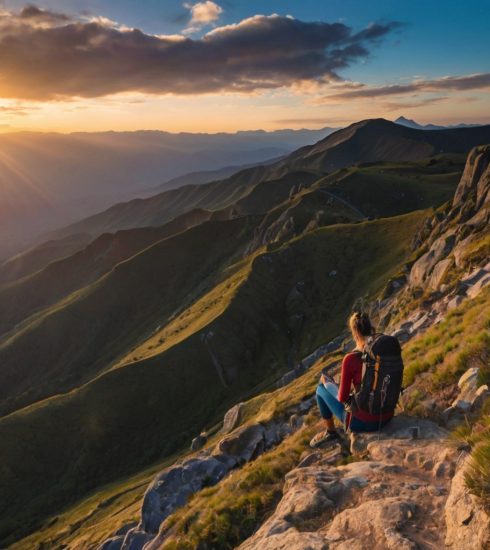How to Travel Solo Safely: Tips for Independent Explorers
Are you ready to embark on a solo travel adventure? Whether you’re a seasoned explorer or new to solo travel, traveling solo can be an incredibly enriching and empowering experience. However, it’s essential to prioritize your safety and take necessary precautions along the way. This article will provide essential tips and advice to help you travel solo safely and confidently.
Key Takeaways:
- Research your destination thoroughly to understand local customs and safety concerns.
- Create a well-planned itinerary and book accommodations in advance
- Pack bright and light to avoid becoming a target for theft
- Stay connected with loved ones by sharing your contact details and itinerary
- Be aware of your surroundings and trust your instincts
Research Your Destination
Before embarking on your solo adventure, it is crucial to research your destination thoroughly. By conducting thorough research, you can equip yourself with valuable knowledge about the area’s local customs, traditions, and laws. Moreover, understanding any safety concerns specific to your destination will empower you to make informed decisions that will contribute to your overall well-being and security.
Researching your destination allows you to immerse yourself in the local culture and blend in with the locals seamlessly. By familiarizing yourself with the cultural norms, you can appreciate and respect the community’s traditions, minimizing potential risks or misunderstandings. Remember, respecting and embracing the local customs enhances your travel experience and fosters positive interactions with the locals, who can provide invaluable insights into the best places to visit and things to do.
Why research is important
“Research is like a compass that navigates you through uncharted territories. It connects you to the essence of a destination, enabling you to embrace its culture, respect its traditions, and tread with confidence. It is the key to unlocking a world of meaningful experiences.”- Maria Johnson, Solo Travel Enthusiast
Through diligent research, you can also become aware of any potential safety concerns specific to your destination. This knowledge allows you to make informed decisions and take necessary precautions to ensure your safety. By researching the local customs; you will familiarize yourself with the acceptable attire, appropriate behavior, and social etiquette, which will enable you to adapt seamlessly to your surroundings and blend in with the local community.
In addition to cultural and safety information, research can provide insights into local attractions, hidden gems, and off-the-beaten-path experiences. By discovering these unique aspects of your destination, you can craft an itinerary that reflects your interests and preferences, maximizing your travel experience.
Remember, research is an essential part of preparing for your solo journey. By devoting time to exploring the cultural nuances, safety considerations, and hidden gems of your destination, you can embark on your adventure with confidence and make the most of every moment.
| Research Benefits | Why it matters |
|---|---|
| Understanding local customs | Respect the culture and minimize potential risks |
| Familiarizing with safety concerns | Make informed decisions and take necessary precautions |
| Discovering hidden gems | Experience unique aspects of your destination |
Plan Your Itinerary and Accommodation
Creating a well-thought-out itinerary is essential for a smooth solo travel experience. It gives you a sense of structure and direction and ensures that you make the most of your trip. Start by listing the places you want to visit, considering your interests, available time, and budget. Research the must-see attractions, hidden gems, and local experiences to include in your itinerary. This way, you can make the most of your solo adventure and create lasting memories.
Booking your accommodations in advance is another crucial aspect of solo travel planning. By securing your accommodation early, you can avoid the stress of finding a place to stay upon arrival, especially if you’re visiting a popular destination or during peak travel seasons. Research different accommodation options, such as hotels, hostels, and vacation rentals, to find the one that fits your preferences and budget. Consider location, safety, and amenities to ensure a comfortable and convenient stay.
Remember, flexibility is key when creating your itinerary. Leave room for spontaneity and unexpected discoveries along the way. While having a rough plan is essential, embrace the freedom to deviate from it if a new opportunity arises. Traveling solo allows you to follow your rhythm and explore at your own pace, so take advantage of it.
Tip: Share your itinerary with a trusted family member or friend. This way, someone back home knows your whereabouts and can reach out if needed.
“A good traveler has no fixed plans and is not intent on arriving.” – Lao Tzu
Sample Itinerary:
| Day | Destination | Activities |
|---|---|---|
| Day 1 | New York City | Explore Central Park, visit the Metropolitan Museum of Art, and enjoy dinner in Little Italy. |
| Day 2 | San Francisco | Explore Central Park, visit the Metropolitan Museum of Art, enjoy dinner in Little Italy. |
| Day 3 | Miami | Walk across the Golden Gate Bridge, visit Alcatraz Island, try local seafood at Fisherman’s Wharf. |
Pack Smart and Light
When embarking on a solo journey, it’s crucial to pack smart and light. Traveling light not only saves you from the hassle of lugging around heavy bags, but it also helps you stay agile and minimizes the risk of losing your belongings. Here are some essential tips to help you pack efficiently:
1. Make a Packing List
Before packing, create a detailed list of the items you need. This will help you stay organized and ensure you don’t forget any essentials. Prioritize the items based on their importance and functionality, focusing on versatile pieces that can be mixed and matched.
2. Choose Multipurpose Items
Opt for clothing and accessories that serve multiple purposes. For example, pack clothing items that can be dressed up or down, and bring shoes that are comfortable for walking during the day and suitable for a more formal setting at night. This will save space and give you more outfit options.
3. Pack Travel-sized Toiletries
Instead of carrying full-sized toiletry products, invest in travel-sized containers or purchase travel-sized versions of your favorite products. If you’re flying, this will help you save space and comply with the TSA liquid restrictions.
4. Roll Your Clothing
Rather than folding your clothes, roll them up tightly to save space in your suitcase. This packing technique prevents wrinkles and allows you to fit more items into a compact space.
5. Use Packing Cubes
Packing cubes are a game-changer when it comes to organizing your luggage. These lightweight cubes help you separate different clothing and accessories, making it easier to find what you need without creating a messy suitcase.
6. Pack Essential Electronics
If you’re bringing electronics such as a laptop, camera, or smartphone, pack them in your carry-on bag to ensure their safety. Consider investing in a compact and lightweight charging station to minimize the number of chargers and cables you need to carry.
“Traveling light gives you the freedom to explore without being weighed down by unnecessary baggage.” – Unknown
By adhering to these packing tips and keeping your luggage light, you’ll easily navigate your solo adventure. Remember, it’s all about being prepared and organized while keeping your belongings secure. Pack bright, pack light, and get ready for an unforgettable journey!
Stay Connected
When traveling solo, staying connected with your loved ones is essential for peace of mind and safety. By sharing your contact details and itinerary with them, they can stay informed about your whereabouts and well-being.
An easy way to stay connected is by checking in regularly. Whether it’s a quick message or a phone call, keeping in touch lets your loved ones know you’re safe and enjoying your journey.
To ensure reliable communication, consider purchasing a local SIM card or a portable WiFi device for your phone. This way, you can have internet access wherever you go, making it easier to stay connected and browse for information.
Remember, being connected keeps your loved ones informed and provides you with an additional layer of security and support during your solo travels.
Be Aware of Your Surroundings
When you’re traveling solo, being aware of your surroundings is paramount. It’s essential to stay alert and note the people and environment around you. By staying mindful of who is in your immediate vicinity, you can better assess potential risks and ensure your safety.
Trust your instincts—awareness is your best defense. If a situation or person feels off, don’t hesitate to remove yourself from it. Avoid walking alone in unfamiliar or unsafe areas, especially at night. Instead, opt for well-lit, crowded areas or consider using reliable transportation options.
“Being aware is not just about seeing your surroundings, but understanding them too. It’s about being present and recognizing changes or unusual behaviors. So, stay observant and be proactive in ensuring your safety.”- Travel safety expert, Sarah Johnson
Staying Safe in Urban Environments
When exploring urban environments, it’s crucial to be vigilant. Pay attention to your surroundings by observing street signs, landmarks, and the flow of pedestrian and vehicular traffic. Stay on well-traveled paths and avoid isolated or poorly lit areas.
Blend in with the locals by dressing modestly and avoiding flashy attire or expensive jewelry that might draw unnecessary attention. By behaving discreetly, you can minimize your vulnerability as a solo traveler.
Exploring Natural and Remote Areas
When venturing into natural or remote areas, research and understand the specific risks associated with that environment. Familiarize yourself with any wildlife species, weather conditions, or potential hazards. Additionally, inform someone trustworthy about your plans and expected return time.
Carry a map, a fully charged phone with GPS capabilities, and any necessary safety equipment. These precautions will allow you to confidently explore, even in unfamiliar and potentially challenging environments.
Blend In with the Locals
Blending in with the locals as much as possible is essential to truly immerse yourself in the local culture and ensure a more authentic travel experience. By respecting their customs and traditions, you not only show appreciation for their way of life but also minimize the chances of standing out as a tourist and becoming a target for potential scams or unwelcome attention.
One of the easiest ways to blend in is by dressing modestly, following the local dress code, and avoiding clothing that may be considered inappropriate or disrespectful. Researching the cultural norms beforehand will give you valuable insights into the appropriate attire for different settings or occasions. Remember, clothing can be a powerful means of communication, so make sure yours sends the right message to the locals.
Another way to blend in is by learning a few basic phrases in the local language. Greetings, common expressions, and simple words like “thank you” and “excuse me” can go a long way in establishing a connection with the locals. It shows that you respect their language and are trying to communicate on their terms.
“When you embrace the local customs and make an effort to blend in, you open the door to meaningful interactions and create opportunities to learn and grow as a traveler.” – Local Travel Enthusiast
Engaging with the locals also means respecting their customs and traditions. Observe and follow cultural practices, such as removing your shoes before entering a temple or covering your shoulders when visiting religious sites. Understanding and participating in local traditions can lead to unforgettable experiences and foster genuine connections.
Ultimately, blending in with the locals allows you to experience a destination more authentically, gain a deeper understanding of the local way of life, and create lasting memories beyond the typical tourist attractions. By respecting the customs, dressing appropriately, and learning key phrases, you can confidently navigate the local community and be welcomed as a fellow traveler.
Use Reliable Transportation
When traveling solo, prioritizing your safety is paramount, and choosing reliable transportation options is crucial. Researching local transportation methods and selecting reputable companies or services will provide you with peace of mind throughout your journey.
One key step in ensuring reliable transportation is being aware of the various options available in your destination. Research the public transportation system, such as buses, trains, or trams, and familiarize yourself with its schedules and routes. Navigating the local system will help you feel confident and secure.
Traveling alone can be an exciting adventure, but it’s essential to prioritize your safety at every turn. Choosing reliable transportation options is a critical step in ensuring a smooth journey.
If public transportation isn’t your preferred choice, consider using reputable ride-sharing services like Uber or Lyft. These platforms provide a convenient and reliable option, allowing you to request a ride and track your driver’s progress quickly.
However, it’s crucial to remain cautious and vigilant when utilizing ride-sharing services. Verify that the vehicle and driver match the information provided in the app, and be wary of any suspicious or irregular behavior.
Comparison of Reliable Transportation Options
| Transportation Option | Pros | Cons |
|---|---|---|
| Public Transportation | – Extensive coverage – Cost-effective – Environmentally friendly | – May have limited operating hours – Potential for overcrowding – Less flexible |
| Ride-Sharing Services | – Convenient and easy to use – Reliable pick-up and drop-off – Transparent pricing | – Requires access to a smartphone – Possible surge pricing during peak hours – Possibility of unfamiliar drivers |
| Taxi Services | – Available 24/7 – Experienced and knowledgeable drivers – Fixed pricing | – Higher fares compared to other options – Potential for dishonest drivers – Limited availability in certain areas |
When traveling alone, avoiding traveling in unmarked or unofficial taxis is essential. These vehicles may lack proper licensing, insurance, and safety standards, risking your well-being. Stick to well-known taxi companies or use reputable ride-sharing services instead.
By incorporating these safety measures and choosing reliable transportation options, you can navigate your solo adventure confidently and enjoy a hassle-free and secure journey.
Take Precautions with Your Money and Documents
When traveling solo, it’s crucial to ensure the safety of your money and important documents. Taking a few precautions can minimize the risk of theft or loss, giving you peace of mind throughout your journey.
Use Multiple Storage Options
It’s wise to have multiple storage options for your money and documents. Consider keeping electronic copies of your passport, insurance, and other essential documents. Store these electronic copies in a secure cloud storage service or email them to yourself to access them even if your physical copies are lost or stolen.
Avoid carrying large amounts of cash on your person. Instead, distribute your money in different places, such as a hidden travel belt, a secure pouch, or separate pockets. If you lose one stash, you’ll still have others intact.
Be Cautious with Public Handling of Cash
When handling cash in public, exercise caution to prevent attracting unnecessary attention. Avoid displaying large sums of money or counting your cash in the open. Find a discreet location, such as a private restroom or accommodation, to count or organize your money.
It’s also important to be mindful of your surroundings when withdrawing cash from ATMs. Choose ATMs in well-lit and crowded areas, as they are less likely to be compromised. Shield your PIN while entering it and immediately secure your cash in a safe place. If you notice anything suspicious or unusual about an ATM, trust your instinct and find another one.
Tips to Protect Your Money and Documents
| Tips | Description |
|---|---|
| Use electronic copies | Use ATMs in well-lit and crowded areas to reduce the risk of compromise. |
| Divide your money | Spread your cash across multiple storage options to minimize loss or theft. |
| Avoid public displays | Avoid publically counting or displaying large sums of cash. |
| Choose secure ATMs | ATMs should be used in well-lit and crowded areas to reduce the risk of compromise. |
| Shield your PIN | Always shield your PIN when entering it at an ATM or point-of-sale terminal. |
By implementing these precautions, you can safeguard your money and documents while enjoying your solo travel adventure. Remember to stay vigilant and prioritize your safety at all times.
Trust Your Intuition and Avoid Risky Situations
Your intuition is a powerful tool when traveling solo. It is important to listen to your inner voice, as it often tries to protect you from potential harm. If a situation feels unsafe or uncomfortable, trust your instincts and find a way to remove yourself from that environment.
Avoid putting yourself in risky situations that may compromise your safety. This includes avoiding questionable areas, engaging in risky behaviors, or consuming excessive amounts of alcohol. Exercising caution and making wise choices can ensure a safer and more enjoyable solo travel experience.
Learn Basic Self-Defense Techniques
Knowing basic self-defense techniques can empower you with the skills and confidence to protect yourself in challenging situations. Whether you’re traveling solo or simply want to feel more secure in your everyday life, learning the fundamentals of self-defense can be invaluable.
Consider enrolling in a self-defense class before your trip to gain hands-on experience and guidance from trained professionals. These classes often cover essential techniques like striking, blocking, and escaping familiar holds. By practicing these maneuvers in a controlled environment, you’ll become more familiar with your physical capabilities and develop muscle memory.
If you prefer to learn at your own pace, numerous online resources, videos, and tutorials provide step-by-step instructions for basic self-defense moves. Platforms like YouTube offer a wide range of self-defense tutorials that cater to different skill levels. Some popular online instructors even specialize in self-defense, specifically for travelers.
Remember, prevention and awareness are your best allies regarding personal safety. Developing a keen sense of your surroundings and being mindful of potential risks can help you avoid dangerous situations. While self-defense techniques can provide you with the tools to protect yourself, it’s essential to prioritize your safety by staying vigilant, trusting your instincts, and being proactive in your security.
By incorporating basic self-defense techniques into your skill set, you’ll feel more empowered and prepared to navigate the world around you confidently.
Connect with Fellow Travelers and Locals
Solo travel doesn’t mean you have to be alone all the time. Connect with fellow travelers and locals to enhance your travel experience and create meaningful connections. By engaging with others, you can gain valuable insights into the culture, discover hidden gems, and find trusted recommendations for activities and places to visit. Here are some ways to connect with fellow travelers and locals:
Join Online Forums and Social Media Groups
Online forums and social media groups dedicated to travel provide a platform for travelers to connect, share experiences, and exchange advice. Join these communities and actively participate by asking questions, sharing your tips, and connecting with like-minded individuals. It’s a great way to find travel buddies, get insider knowledge on destinations, and receive real-time updates and recommendations.
Attend Organized Meetups
Many cities and travel destinations offer organized meetups and events specifically designed for travelers. These gatherings allow one to meet fellow travelers, exchange stories, and make new friends. Look for local events such as language exchanges, cultural workshops, or group activities like hiking or food tours. These experiences foster connections and provide a safe and enjoyable way to explore the destination.
Engage with Locals
Connecting with locals is an incredible way to immerse yourself in the local culture and gain an authentic travel experience. Strike up conversations with locals at cafes, markets, or community events. Ask for recommendations on the best local spots, restaurants, or off-the-beaten-path attractions. Locals are often eager to share their knowledge and insights, giving you a unique perspective on the destination.
“Traveling solo allows you the freedom to form deep connections with both fellow travelers and locals. Embrace the opportunity to learn from others and create lifelong memories together.”
Remember, building connections with fellow travelers and locals enriches your travel experience and provides a support network along the way. From sharing travel tips to creating unforgettable adventures, these connections can turn your solo journey into a memorable and transformative experience.
Conclusion
Traveling solo can be an enriching experience. By following these safety tips, you can navigate your journey confidently and enjoy the freedom and excitement of exploring the world on your terms. Remember, your safety is paramount, so always prioritize your well-being while embracing the adventure.
FAQ
How can I research my destination before traveling solo?
Before traveling solo, it’s important to research your destination thoroughly. Learn about the local customs, traditions, laws, and safety concerns. Understanding the cultural norms will help you blend in and minimize potential risks.
How should I plan my itinerary and book accommodations?
Creating a well-thought-out itinerary and booking your accommodations in advance will give you a sense of structure and security while traveling solo. Share your itinerary with a trusted family member or friend so they can keep track of your whereabouts.
What should I pack when traveling solo?
When traveling solo, it’s essential to pack efficiently. Bring only the necessary items to avoid becoming a target for theft or pickpocketing. Keep your valuables, such as passports and money, in a secure place like a money belt or hidden pocket.
How can I stay connected with my loved ones while traveling solo?
It’s essential to stay connected with your loved ones while traveling solo. Please share your contact details and itinerary with them, and check in regularly. Consider purchasing a local SIM card or a portable WiFi device for reliable communication.
What precautions should I take with my money and documents?
Keep your money and important documents safe by using multiple storage options. Consider keeping copies of your passport, insurance, and other essential documents electronically. Use ATMs in well-lit and crowded areas, and be cautious when handling cash in public.
How can I trust my intuition and avoid risky situations?
Your intuition is a powerful tool when traveling solo. If a situation feels unsafe or uncomfortable, trust your instincts and find a way to remove yourself from that environment. Avoid risky behaviors, excessive alcohol consumption, and taking unnecessary risks.
Are there any self-defense techniques I should learn?
Knowing basic self-defense techniques can help boost your confidence and give you a sense of security. Consider taking a self-defense class before your trip or learning simple moves online. Remember, prevention and awareness are your best allies.
How can I connect with other travelers and locals while traveling solo?
Solo travel doesn’t mean you have to be alone all the time. Connect with fellow travelers through online forums, social media groups, or organized meetups. Engage with locals to gain insights into the culture and find trusted recommendations for activities and places to visit.






